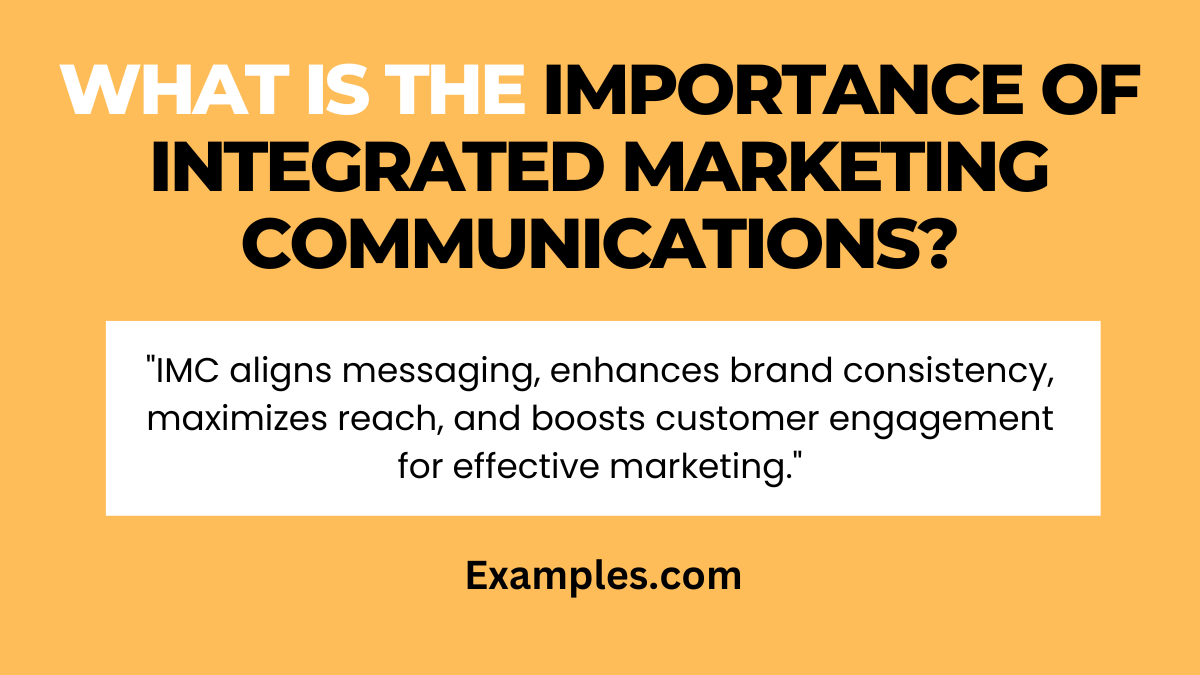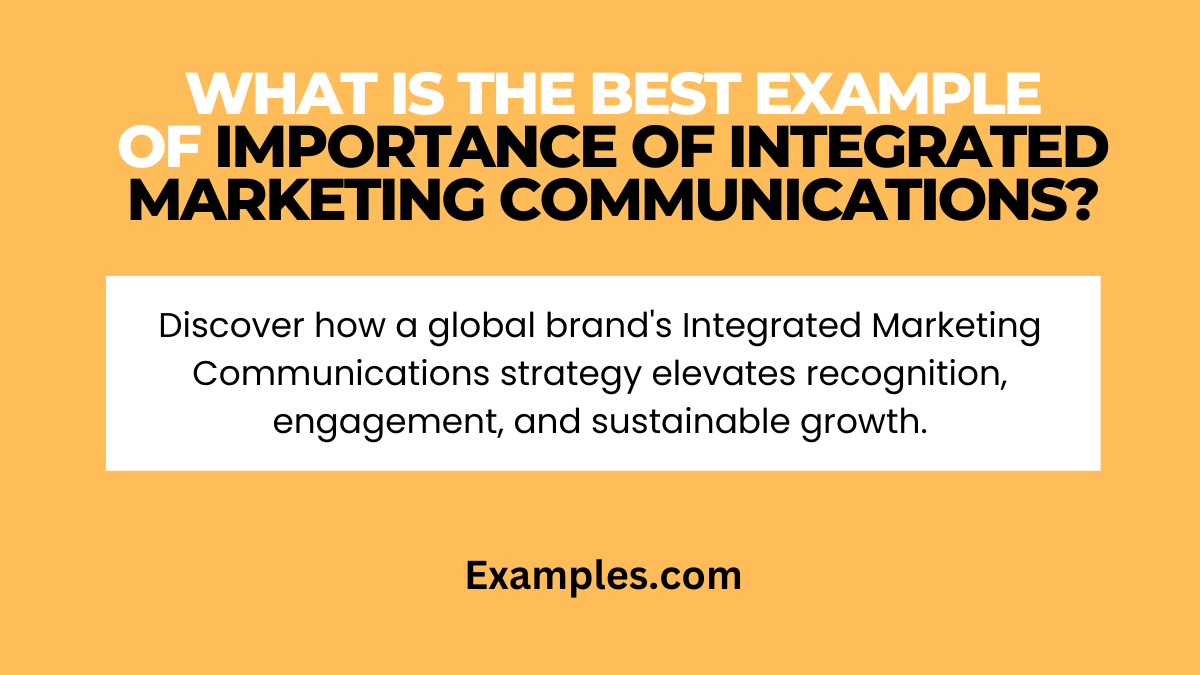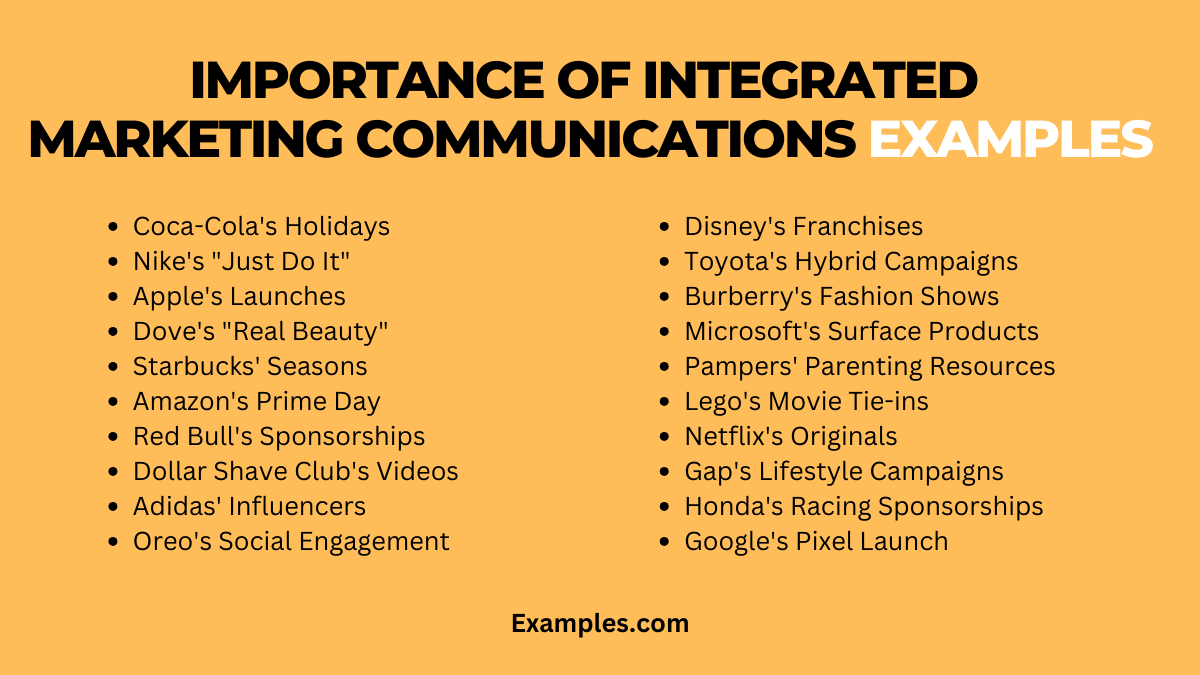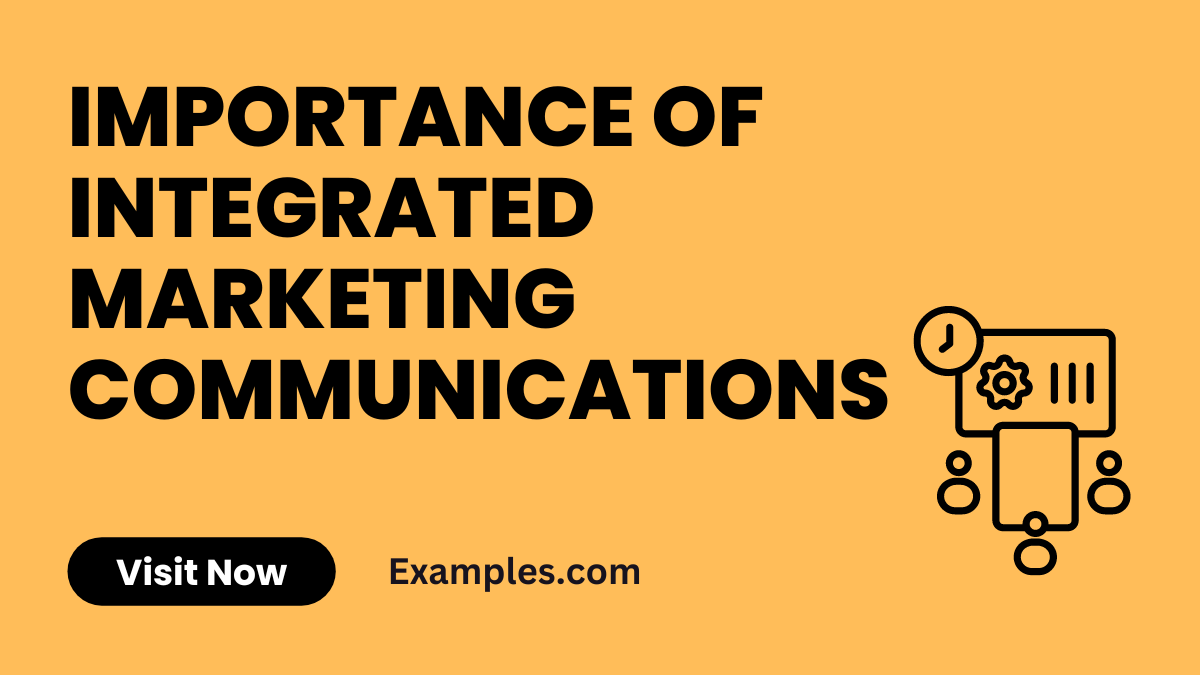19+ Importance of Integrated Marketing Communications Examples
Embark on a journey through the pivotal realm of Integrated Marketing Communications (IMC). Uncover the core definition, explore its significance in the marketing landscape, and delve into a standout example illustrating how IMC transforms communication strategies, creating impactful connections and driving business success. Join us in deciphering the intricate tapestry of integrated marketing communication with real-world examples that showcase its unparalleled effectiveness.
What is the Importance of Integrated Marketing Communications?

Integrated Marketing Communications (IMC) is a strategic approach that ensures all elements of a marketing plan work harmoniously to convey a consistent message. It unifies diverse communication channels to maximize impact, strengthen brand identity, and foster seamless customer experiences.
What is the Best Example of Importance of Integrated Marketing Communications?

Explore the success story of a global brand that seamlessly integrates advertising, public relations, digital marketing, and more. Learn how their cohesive approach boosts brand recognition, engages diverse audiences, and ultimately drives sustained business growth.
20 Importance of Integrated Marketing Communications Examples

Explore the synergy of effective marketing with these Importance of Integrated Marketing Communications examples. Witness how businesses blend strategies for amplified brand messages, engaged audiences, and marketing excellence. Embrace integration’s power for a cohesive approach to leave a lasting impact.
- Coca-Cola’s Holidays: Unified TV, social, and in-store promotions boost brand recall during festive seasons.
- Nike’s “Just Do It”: Coordinated TV, digital, and influencer efforts convey a consistent message of empowerment.
- Apple’s Launches: Events, teasers, and showcases create anticipation, maintaining a consistent brand image.
- Dove’s “Real Beauty”: Integrated TV, digital, and social messaging promote diversity and self-acceptance globally.
- Starbucks’ Seasons: Synchronized promotions on social, in-store, and emails enhance anticipation for seasonal products.
- Amazon’s Prime Day: Email, social, and exclusive deals synchronize for a buzz, driving sales and loyalty.
- Red Bull’s Sponsorships: Aligning extreme sports sponsorships and content creation strengthens brand identity.
- Dollar Shave Club’s Videos: Humorous online videos drive brand awareness, traffic, and conversions.
- Adidas’ Influencers: Seamless integration of influencers enhances authenticity and brand image.
- Oreo’s Social Engagement: Timely and creative social media posts align with events, enhancing brand relevance.
- Disney’s Franchises: Cross-platform storytelling, from movies to merchandise, creates a unified brand experience.
- Toyota’s Hybrid Campaigns: Integrated messaging across platforms emphasizes sustainability and innovation.
- Burberry’s Fashion Shows: Merging digital and physical experiences for runway shows amplifies global reach.
- Microsoft’s Surface Products: Coordinated ads, events, and influencer collaborations drive product awareness.
- Pampers’ Parenting Resources: Integrating online content with product promotion supports a holistic brand image.
- Lego’s Movie Tie-ins: Collaborative marketing across movies and products enhances brand affinity.
- Netflix’s Originals: Simultaneous cross-platform promotions boost the launch of original content.
- Gap’s Lifestyle Campaigns: Integrating products into lifestyle content enhances brand association.
- Honda’s Racing Sponsorships: Aligning with racing events reinforces the brand’s performance-oriented image.
- Google’s Pixel Launch: Multi-channel approach involving online events, reviews, and ads ensures a wide reach.
Importance of Integrated Marketing Communications Examples in Advertising
Discover the pivotal role of integrated marketing communications in the advertising landscape. These examples showcase how seamless integration enhances advertising effectiveness, ensuring a harmonized brand message across diverse channels for optimal audience impact.
- Nike’s “Dream Crazy”: The iconic campaign integrated TV, online videos, and social media to convey a powerful message of empowerment and social justice.
- Apple’s Product Launches: Through synchronized ads, events, and online promotions, Apple ensures consistent communication during product releases, driving anticipation and sales.
- Coca-Cola’s Share a Coke Campaign: By harmonizing TV, social media, and personalized packaging, Coca-Cola achieved widespread engagement and customer interaction.
- Dove’s Real Beauty Sketches: Integrated across TV, digital, and social platforms, Dove’s campaign redefined beauty standards, fostering a positive brand image.
- Amazon’s Holiday Shopping Events: Through a combination of email, social media, and exclusive deals, Amazon creates a unified buzz during holiday seasons, driving sales and customer loyalty.
What is the Importance of Integrated Marketing Communications Strategies?
Understanding the crucial role of integrated marketing communications (IMC) strategies is vital for businesses seeking comprehensive brand promotion. IMC harmonizes diverse communication channels, ensuring a unified and impactful brand message across platforms.
- Strategic Planning: Craft a detailed IMC plan, aligning marketing efforts with business objectives and target audience preferences.
- Consistent Messaging: Maintain a cohesive brand message across various communication channels, reinforcing brand identity and recognition.
- Channel Integration: Seamlessly integrate diverse channels, such as digital, social media, and traditional advertising, for synchronized communication.
- Audience Segmentation: Identify and understand specific audience segments, tailoring communication strategies to resonate with diverse demographics.
- Measurement and Analytics: Implement metrics to evaluate the effectiveness of each communication channel, enabling data-driven adjustments for optimal results.
- Adaptability and Innovation: Stay abreast of industry trends, evolving technologies, and consumer behaviors to adapt and innovate IMC strategies accordingly.
What is the Importance of Integrated Marketing Communications in Building a Cohesive Brand Identity?
Understanding the critical role integrated marketing communications (IMC) plays in crafting a unified brand identity is paramount. This guide explores the significance of IMC in establishing a cohesive brand image and its impact on overall brand perception.
- Strategic Planning: Begin by aligning IMC strategies with overall business goals and values to ensure a unified brand message.
- Consistent Messaging: Emphasize the importance of conveying a consistent brand message across all communication channels, reinforcing brand identity.
- Audience Segmentation: Tailor communication strategies based on audience segments, recognizing the diverse preferences and behaviors within the target market.
- Multichannel Integration: Explore the benefits of integrating various communication channels, such as social media, PR, and advertising, for a synchronized brand narrative.
- Feedback Mechanisms: Establish feedback loops to assess the effectiveness of IMC strategies, allowing for timely adjustments and improvements.
- Employee Training: Educate internal teams on the significance of their roles in maintaining brand consistency, fostering a shared understanding of IMC’s importance.
How Organizations Effectively Communicate the Importance of Integrated Marketing Communications to Internal Stakeholders?
This section delves into the strategies organizations can employ to effectively communicate the significance of integrated marketing communications (IMC) to internal stakeholders, ensuring alignment and commitment.
- Internal Workshops: Conduct workshops to educate employees about IMC, emphasizing its role in enhancing brand cohesion and achieving marketing objectives.
- Case Studies: Share successful IMC case studies within the industry, showcasing tangible results and highlighting the positive impact on brand reputation.
- Clear Documentation: Develop concise documentation outlining IMC principles, benefits, and its direct correlation to organizational success for easy comprehension.
- Interactive Training Modules: Utilize interactive training modules that allow employees to grasp IMC concepts through engaging and practical learning experiences.
- Regular Updates: Provide regular updates on IMC initiatives, showcasing achievements and reinforcing its ongoing importance within the organizational framework.
- Open Communication Channels: Foster an environment where internal stakeholders can freely communicate their thoughts and concerns about IMC, promoting a collaborative approach.
What are the Benefits Associated with Importance of Integrated Marketing Communications?
Explore the dynamic landscape of today’s markets and understand the tangible benefits that businesses can derive by recognizing and implementing integrated marketing communications (IMC) strategies.
- Adaptability: Recognizing the importance of IMC allows businesses to stay adaptable, responding swiftly to market changes and emerging trends.
- Brand Resilience: Implementing IMC ensures brand resilience, allowing businesses to maintain a strong and positive brand image even in challenging situations.
- Enhanced Customer Experience: Businesses embracing IMC deliver a seamless and cohesive customer experience, fostering loyalty and satisfaction.
- Competitive Edge: Understanding IMC provides a competitive edge by enabling businesses to differentiate themselves through consistent and impactful messaging.
- Data-Driven Decision Making: Leveraging IMC strategies allows businesses to make informed decisions based on comprehensive data, enhancing marketing effectiveness.
- Maximized ROI: By recognizing the importance of IMC, businesses can maximize their return on investment, ensuring that marketing efforts yield measurable and sustainable results.
In conclusion, embracing the importance of Integrated Marketing Communications (IMC) is pivotal for businesses navigating today’s dynamic markets. This comprehensive guide elucidates the role of IMC in building brand identity, communicating its significance internally, and reaping tangible benefits. As organizations recognize the power of IMC, they position themselves for resilience, customer loyalty, and a competitive edge, ensuring marketing success in an ever-evolving landscape.



